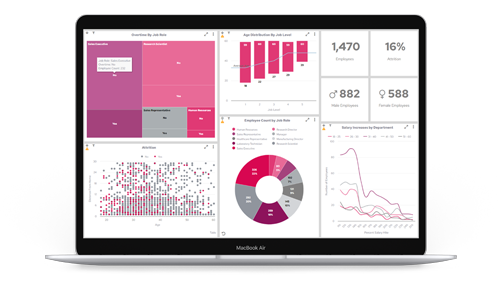Key takeaways
- The key differences between business intelligence (BI) platforms and embedded analytics software.
- The advantages and limitations of using business intelligence (BI) platforms for data analysis and decision-making.
- How embedded analytics software enhances user experience and operational efficiency by integrating analytical capabilities directly into business applications.
The terms embedded analytics and business intelligence often get used interchangeably. Both are powerful tools for uncovering vital insights from complex data. Embedded analytics vs business intelligence: what is the difference? Let's dive in and find out!
What is a business intelligence platform?
A business intelligence platform is a technology-based process for examining data and delivering actionable insights to assist executives, managers, and other corporate users in making well-informed business decisions.
These platforms include a range of tools, applications, and methodologies that allow organizations to gather data from both internal systems and external sources, prepare it for analysis, execute queries on the data, and generate reports, dashboards, and data visualisations. BI platforms are built to manage large data volumes and offer insights that can influence strategic and tactical business choices.
What are the advantages of a business intelligence platform?
Business intelligence platforms offer numerous advantages that can significantly enhance an organization's decision-making capabilities.
Actionable insights
One of the primary benefits is the ability to transform vast amounts of raw data into actionable insights. By leveraging data integration, cleansing, and modelling, BI platforms provide a comprehensive view of an organization's operations, enabling users to identify trends, monitor performance, and make data-driven decisions. This holistic approach ensures that decision-makers have access to accurate and timely information, which is crucial for strategic planning and operational efficiency.
Improved operational efficiency
Another key advantage of BI platforms is their ability to improve operational efficiency. By automating data collection and analysis processes, these platforms reduce the time and effort required to generate reports and dashboards. This automation not only saves valuable time but also minimises the risk of human error, ensuring that the data is reliable and consistent.
What are the limitations of a business intelligence platform?
The following constraints highlight the necessity for a more cohesive and intuitive solution. An effective strategy provides smooth integration with business applications, allowing immediate access to data within the workflow.
- Implementing business intelligence systems can be difficult and resource-demanding, necessitating considerable time and technical know-how.
- Utilizing BI tools effectively often requires specialized skills, which may result in the need for additional training or hiring expert staff.
- Conventional BI tools might not integrate smoothly into everyday workflows, leading to disruptions and decreased user engagement.
- Without proper integration with other systems, BI can create data silos, hindering a comprehensive view of business operations.
- BI systems may lack the flexibility to swiftly adapt to rapidly changing business environments, reducing their effectiveness in dynamic markets.
What is embedded analytics software?
Embedded analytics software blends analytical tools right into the business apps you use every day. This means you can check out and play with data insights without leaving your usual workflow. Unlike traditional business intelligence platforms, where you often have to jump between different systems to look at data, embedded analytics puts the power of data analysis right where you make decisions. This smooth integration makes things easier for you and ensures that data-driven insights are always at your fingertips when you need them most.
What are the advantages of embedded analytics?
Embedded analytics offers several compelling advantages that can significantly enhance the way organizations interact with and utilise their data.
Seamless integration into business applications
One of the main perks of embedded analytics is the seamless intergration into business applications. This means users don't have to jump between different systems to get data insights, making everything run more smoothly and efficiently. With analytics built into their daily tools, users can make data-driven decisions faster and more effectively.
Real-time data analysis
One great thing about embedded analytics is that it gives you real-time data analysis. This is super handy in fast-paced settings where you need up-to-the-minute info. For example, sales teams can keep an eye on key performance indicators (KPIs) and customer behavior right within their customer relationship management (CRM) systems. Having this real-time data means they can tweak their strategies on the go, making them more responsive to market changes and customer needs.
Full customization to keep brand consistency
Customization is another big plus of embedded analytics. Companies can tweak the analytics interface to match their branding and design, making sure everything looks and feels consistent. This even includes white-labeling options, so businesses can make the analytics look like a natural part of their app. Plus, embedded analytics supports multi-tenancy, which is perfect for SaaS providers. Multi-tenancy lets multiple users or clients use the same app while keeping their data separate and secure, which is super important for data privacy and security in different user settings.
More accessible data analytics for everyone
Embedded analytics software is great for self-service BI reporting. Every user of your application can easily access data and find insights without needing to know or write any code. This means you don’t have to ask your IT team for help to build reports or analyze data; users can do it themselves. Self-service reporting has several benefits, the main one being that it makes data analytics accessible to everyone. Plus, it boosts productivity by helping you quickly find insights.
What are the limitations of an embedded analytics platform?
The primary limitation of embedded analytics is its dependency on the host application. This means that the analytics capabilities are restricted by the features and functionalities of the software in which they are integrated.
It's important to correctly evaluate embedded analytics providers thoroughly to make sure it fits your organizations needs.
Embedded analytics vs business intelligence: The main differences
| Business intelligence | Embedded analytics | |
|---|---|---|
| Integration into systems | Usually works as a separate system, requiring users to switch between different apps to get insights. | Seamlessly incorporated into business software, offering insights within the user's standard workflow. |
| Skill level | Usually requires some know-how or experience with the tool to use it effectively. | Designed to be easy for everyone to use, not just data experts, encouraging more people to take advantage of it. |
| Real-time data analysis | Usually doesn't offer real-time analysis and often relies on scheduled reports. | Gives you quick insights, so you can make decisions right away using the latest info. |
| Level of customization | While customization is possible, it can be complex and you might need some help from IT experts. | Highly customizable. Easily adjusts to fit the specific needs of the application it's paired with. |
| Deployment | Implemented as a separate platform or service, different from the main business applications. | Integrated seamlessly into your existing business apps, making everything feel like one smooth experience. |
| Workflow impact | May disrupt your workflow since you have to switch to another system to get insights. | Enhances workflow by providing insights that are directly relevant to the current task or application. |
| Implementation | The implementation process can be intricate, frequently demanding substantial time and resources. | Although integration may pose difficulties, it is incorporated directly into the application, making the process more straightforward. |
| Ease of use | Adoption may be difficult if users perceive the platform as overly complicated or irrelevant to their routine activities. | Increased user adoption due to its alignment with users' current application usage and typically more intuitive nature. |
| Cost | High cost of software, training and possibly additional staff to close the skill gap. | Expenses are frequently reduced because of the integration with current systems and the decreased need for training. |
Conclusion
While both business intelligence and embedded analytics help improve decision-making with data, they differ in how they're integrated and accessed. BI usually operates as a standalone system that requires expert knowledge to analyze data. On the other hand, embedded analytics is built right into business applications, offering real-time insights that everyone can easily access.
FAQ
BI platforms are standalone systems for data collection, processing, and analysis, requiring users to switch between systems. Embedded analytics integrates analytical capabilities directly into business applications, allowing real-time data access within everyday workflows. Embedded analytics also offers more customisation and supports multi-tenancy.
Panintelligence is an embedded analytics sofware. Panintelligence embeds directly into applications to not break users workflow by switching between different pieces of software.
Benefits of embedded analytics include seamless integration into business applications, real-time data analysis, extensive customisation options, and support for multi-tenancy. These features streamline workflows, improve efficiency, and ensure data-driven insights are accessible in real-time.























